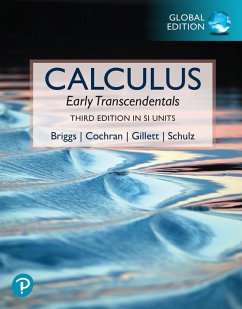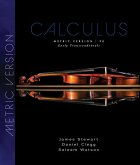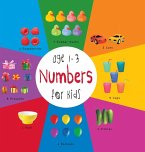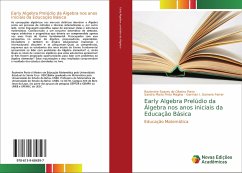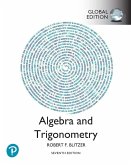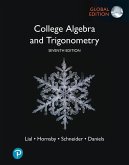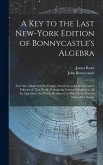William Briggs, William L. Briggs, Lyle Cochran, Bernard Gillett, Eric Schulz
Calculus: Early Transcendentals, Global Edition
William Briggs, William L. Briggs, Lyle Cochran, Bernard Gillett, Eric Schulz
Calculus: Early Transcendentals, Global Edition
- Broschiertes Buch
- Merkliste
- Auf die Merkliste
- Bewerten Bewerten
- Teilen
- Produkt teilen
- Produkterinnerung
- Produkterinnerung
For 3- to 4-semester courses covering single-variable and multivariable calculus, taken by students of mathematics, engineering, natural sciences, or economics. The most successful new calculus text in the last two decades The much-anticipated 3rd Edition of Briggs' Calculus retains its hallmark features while introducing important advances and refinements. Briggs, Cochran, Gillett, and Schulz build from a foundation of meticulously crafted exercise sets, then draw students into the narrative through writing that reflects the voice of the instructor. Examples are stepped out and thoughtfully…mehr
Andere Kunden interessierten sich auch für
![Calculus: Early Transcendentals, Metric Edition Calculus: Early Transcendentals, Metric Edition]() James StewartCalculus: Early Transcendentals, Metric Edition90,99 €
James StewartCalculus: Early Transcendentals, Metric Edition90,99 €![Numbers for Kids age 1-3 (Engage Early Readers Numbers for Kids age 1-3 (Engage Early Readers]() Dayna MartinNumbers for Kids age 1-3 (Engage Early Readers28,99 €
Dayna MartinNumbers for Kids age 1-3 (Engage Early Readers28,99 €![Early Algebra Prelúdio da Álgebra nos anos iniciais da Educação Básica Early Algebra Prelúdio da Álgebra nos anos iniciais da Educação Básica]() Rozimeire Soares de Oliveira PortoEarly Algebra Prelúdio da Álgebra nos anos iniciais da Educação Básica50,99 €
Rozimeire Soares de Oliveira PortoEarly Algebra Prelúdio da Álgebra nos anos iniciais da Educação Básica50,99 €![Algebra and Trigonometry, Global Edition Algebra and Trigonometry, Global Edition]() Robert BlitzerAlgebra and Trigonometry, Global Edition68,99 €
Robert BlitzerAlgebra and Trigonometry, Global Edition68,99 €![College Algebra and Trigonometry, Global Edition College Algebra and Trigonometry, Global Edition]() Margaret LialCollege Algebra and Trigonometry, Global Edition69,99 €
Margaret LialCollege Algebra and Trigonometry, Global Edition69,99 €![A Key to the Last New-York Edition of Bonnycastle's Algebra: And Also Adapted to the Former American and Latest London Editions of That Work: Containi A Key to the Last New-York Edition of Bonnycastle's Algebra: And Also Adapted to the Former American and Latest London Editions of That Work: Containi]() John BonnycastleA Key to the Last New-York Edition of Bonnycastle's Algebra: And Also Adapted to the Former American and Latest London Editions of That Work: Containi37,99 €
John BonnycastleA Key to the Last New-York Edition of Bonnycastle's Algebra: And Also Adapted to the Former American and Latest London Editions of That Work: Containi37,99 €![Seven Eyes Open: A Study Of The Revelation Of Jesus Christ: (Fourth Edition) Seven Eyes Open: A Study Of The Revelation Of Jesus Christ: (Fourth Edition)]() Alexander J. B. ConnorSeven Eyes Open: A Study Of The Revelation Of Jesus Christ: (Fourth Edition)40,99 €
Alexander J. B. ConnorSeven Eyes Open: A Study Of The Revelation Of Jesus Christ: (Fourth Edition)40,99 €-
-
-
For 3- to 4-semester courses covering single-variable and multivariable calculus, taken by students of mathematics, engineering, natural sciences, or economics. The most successful new calculus text in the last two decades The much-anticipated 3rd Edition of Briggs' Calculus retains its hallmark features while introducing important advances and refinements. Briggs, Cochran, Gillett, and Schulz build from a foundation of meticulously crafted exercise sets, then draw students into the narrative through writing that reflects the voice of the instructor. Examples are stepped out and thoughtfully annotated, and figures are designed to teach rather than simply supplement the narrative. The groundbreaking eText contains approximately 700 Interactive Figures that can be manipulated to shed light on key concepts. For the 3rd Edition, the authors synthesized feedback on the text and MyLab Math content from over 140 instructors. This thorough and extensive review process, paired with the authors' own teaching experiences, helped create a text that is designed for today's calculus instructors and students.
Hinweis: Dieser Artikel kann nur an eine deutsche Lieferadresse ausgeliefert werden.
Hinweis: Dieser Artikel kann nur an eine deutsche Lieferadresse ausgeliefert werden.
Produktdetails
- Produktdetails
- Verlag: Pearson
- 3. Auflage
- Erscheinungstermin: 9. Juli 2025
- Englisch
- ISBN-13: 9781292755076
- ISBN-10: 1292755075
- Artikelnr.: 73156709
- Herstellerkennzeichnung
- Pearson
- St.-Martin-Straße 82
- 81541 München
- salesde@pearson.com
- +4989541960460
- Verlag: Pearson
- 3. Auflage
- Erscheinungstermin: 9. Juli 2025
- Englisch
- ISBN-13: 9781292755076
- ISBN-10: 1292755075
- Artikelnr.: 73156709
- Herstellerkennzeichnung
- Pearson
- St.-Martin-Straße 82
- 81541 München
- salesde@pearson.com
- +4989541960460
About our authors William Briggs has been on the mathematics faculty at the University of Colorado at Denver for 23 years. He received his BA in mathematics from the University of Colorado and his MS and PhD in applied mathematics from Harvard University. He teaches undergraduate and graduate courses throughout the mathematics curriculum, with a special interest in mathematical modeling and differential equations as it applies to problems in the biosciences. He has written a quantitative reasoning textbook, Using and Understanding Mathematics; an undergraduate problem solving book, Ants, Bikes, and Clocks; and two tutorial monographs, The Multigrid Tutorial and The DFT: An Owner's Manual for the Discrete Fourier Transform . He is the Society for Industrial and Applied Mathematics (SIAM) Vice President for Education, a University of Colorado President's Teaching Scholar, a recipient of the Outstanding Teacher Award of the Rocky Mountain Section of the Mathematical Association of America (MAA), and the recipient of a Fulbright Fellowship to Ireland. Lyle Cochran is a professor of mathematics at Whitworth University in Spokane, Washington. He holds BS degrees in mathematics and mathematics education from Oregon State University and a MS and PhD in mathematics from Washington State University. He has taught a wide variety of undergraduate mathematics courses at Washington State University, Fresno Pacific University, and since 1995 at Whitworth University. His expertise is in mathematical analysis, and he has a special interest in the integration of technology and mathematics education. He has written technology materials for leading calculus and linear algebra textbooks including the Instructor's Mathematica Manual for Linear Algebra and Its Applications by David C. Lay and the Mathematica Technology Resource Manual for Thomas' Calculus. He is a member of the MAA and a former chair of the Department of Mathematics and Computer Science at Whitworth University. Bernard Gillett is a Senior Instructor at the University of Colorado at Boulder; his primary focus is undergraduate education. He has taught a wide variety of mathematics courses over a 20-year career, receiving 5 teaching awards in that time. Bernard authored a software package for algebra, trigonometry, and precalculus; the Student's Guide and Solutions Manual and the Instructor's Guide and Solutions Manual for Using and Understanding Mathematics by Briggs and Bennett; and the Instructor's Resource Guide and Test Bank for Calculus and Calculus: Early Transcendentals by Briggs, Cochran and Gillett. Bernard is also an avid rock climber and has published 4 climbing guides for the mountains in and surrounding Rocky Mountain National Park. Eric Schulz has been teaching mathematics at Walla Walla Community College since 1989 and began his work with Mathematica in 1992. He has an undergraduate degree in mathematics from Seattle Pacific University and a graduate degree in mathematics from the University of Washington. Eric loves working with students and is passionate about their success. His interest in innovative and effective uses of technology in teaching mathematics has remained strong throughout his career. He is the developer of the Basic Math Assistant, Classroom Assistant, and Writing Assistant palettes that ship in Mathematica worldwide. He is an author on multiple textbooks: Calculus and Calculus: Early Transcendentals with Briggs, Cochran and Gillett, and Precalculus with Sachs and Briggs, where he writes, codes and creates dynamic eTexts combining narrative, videos and Interactive Figures using Mathematica and CDF technology.
1. Functions
* 1.1 Review of Functions
* 1.2 Representing Functions
* 1.3 Inverse, Exponential, and Logarithmic Functions
* 1.4 Trigonometric Functions and Their Inverses
* Review Exercises
2. Limits
* 2.1 The Idea of Limits
* 2.2 Definitions of Limits
* 2.3 Techniques for Computing Limits
* 2.4 Infinite Limits
* 2.5 Limits at Infinity
* 2.6 Continuity
* 2.7 Precise Definitions of Limits
* Review Exercises
3. Derivatives
* 3.1 Introducing the Derivative
* 3.2 The Derivative as a Function
* 3.3 Rules of Differentiation
* 3.4 The Product and Quotient Rules
* 3.5 Derivatives of Trigonometric Functions
* 3.6 Derivatives as Rates of Change
* 3.7 The Chain Rule
* 3.8 Implicit Differentiation
* 3.9 Derivatives of Logarithmic and Exponential Functions
* 3.10 Derivatives of Inverse Trigonometric Functions
* 3.11 Related Rates
* Review Exercises
4. Applications of the Derivative
* 4.1 Maxima and Minima
* 4.2 Mean Value Theorem
* 4.3 What Derivatives Tell Us
* 4.4 Graphing Functions
* 4.5 Optimization Problems
* 4.6 Linear Approximation and Differentials
* 4.7 L'Hôpital's Rule
* 4.8 Newton's Method
* 4.9 Antiderivatives
* Review Exercises
5. Integration
* 5.1 Approximating Areas under Curves
* 5.2 Definite Integrals
* 5.3 Fundamental Theorem of Calculus
* 5.4 Working with Integrals
* 5.5 Substitution Rule
* Review Exercises
6. Applications of Integration
* 6.1 Velocity and Net Change
* 6.2 Regions Between Curves
* 6.3 Volume by Slicing
* 6.4 Volume by Shells
* 6.5 Length of Curves
* 6.6 Surface Area
* 6.7 Physical Applications
* Review Exercises
7. Logarithmic, Exponential, and Hyperbolic Functions
* 7.1 Logarithmic and Exponential Functions Revisited
* 7.2 Exponential Models
* 7.3 Hyperbolic Functions
* Review Exercises
8. Integration Techniques
* 8.1 Basic Approaches
* 8.2 Integration by Parts
* 8.3 Trigonometric Integrals
* 8.4 Trigonometric Substitutions
* 8.5 Partial Fractions
* 8.6 Integration Strategies
* 8.7 Other Methods of Integration
* 8.8 Numerical Integration
* 8.9 Improper Integrals
* Review Exercises
9. Differential Equations
* 9.1 Basic Ideas
* 9.2 Direction Fields and Euler's Method
* 9.3 Separable Differential Equations
* 9.4 Special First-Order Linear Differential Equations
* 9.5 Modeling with Differential Equations
* Review Exercises
10. Sequences and Infinite Series
* 10.1 An Overview
* 10.2 Sequences
* 10.3 Infinite Series
* 10.4 The Divergence and Integral Tests
* 10.5 Comparison Tests
* 10.6 Alternating Series
* 10.7 The Ratio and Root Tests
* 10.8 Choosing a Convergence Test
* Review Exercises
11. Power Series
* 11.1 Approximating Functions with Polynomials
* 11.2 Properties of Power Series
* 11.3 Taylor Series
* 11.4 Working with Taylor Series
* Review Exercises
12. Parametric and Polar Curves
* 12.1 Parametric Equations
* 12.2 Polar Coordinates
* 12.3 Calculus in Polar Coordinates
* 12.4 Conic Sections
* Review Exercises
13. Vectors and the Geometry of Space
* 13.1 Vectors in the Plane
* 13.2 Vectors in Three Dimensions
* 13.3 Dot Products
* 13.4 Cross Products
* 13.5 Lines and Planes in Space
* 13.6 Cylinders and Quadric Surfaces
* Review Exercises
14. Vector-Valued Functions
* 14.1 Vector-Valued Functions
* 14.2 Calculus of Vector-Valued Functions
* 14.3 Motion in Space
* 14.4 Length of Curves
* 14.5 Curvature and Normal Vectors
* Review Exercises
15. Functions of Several Variables
* 15.1 Graphs and Level Curves
* 15.2 Limits and Continuity
* 15.3 Partial Derivatives
* 15.4 The Chain Rule
* 15.5 Directional Derivatives and the Gradient
* 15.6 Tangent Planes and Linear Approximation
* 15.7 Maximum/Minimum Problems
* 15.8 Lagrange Multipliers
* Review Exercises
16. Multiple Integration
* 16.1 Double Integrals over Rectangular Regions
* 16.2 Double Integrals over General Regions
* 16.3 Double Integrals in Polar Coordinates
* 16.4 Triple Integrals
* 16.5 Triple Integrals in Cylindrical and Spherical Coordinates
* 16.6 Integrals for Mass Calculations
* 16.7 Change of Variables in Multiple Integrals
* Review Exercises
17. Vector Calculus
* 17.1 Vector Fields
* 17.2 Line Integrals
* 17.3 Conservative Vector Fields
* 17.4 Green's Theorem
* 17.5 Divergence and Curl
* 17.6 Surface Integrals
* 17.7 Stokes' Theorem
* 17.8 Divergence Theorem
* Review Exercises
D2 Second-Order Differential Equations ONLINE
* D2.1 Basic Ideas
* D2.2 Linear Homogeneous Equations
* D2.3 Linear Nonhomogeneous Equations
* D2.4 Applications
* D2.5 Complex Forcing Functions
* Review Exercises
Appendices
1. Proofs of Selected Theorems
2. Algebra Review ONLINE
3. Complex Numbers ONLINE
Answers Index Table of Integrals
* 1.1 Review of Functions
* 1.2 Representing Functions
* 1.3 Inverse, Exponential, and Logarithmic Functions
* 1.4 Trigonometric Functions and Their Inverses
* Review Exercises
2. Limits
* 2.1 The Idea of Limits
* 2.2 Definitions of Limits
* 2.3 Techniques for Computing Limits
* 2.4 Infinite Limits
* 2.5 Limits at Infinity
* 2.6 Continuity
* 2.7 Precise Definitions of Limits
* Review Exercises
3. Derivatives
* 3.1 Introducing the Derivative
* 3.2 The Derivative as a Function
* 3.3 Rules of Differentiation
* 3.4 The Product and Quotient Rules
* 3.5 Derivatives of Trigonometric Functions
* 3.6 Derivatives as Rates of Change
* 3.7 The Chain Rule
* 3.8 Implicit Differentiation
* 3.9 Derivatives of Logarithmic and Exponential Functions
* 3.10 Derivatives of Inverse Trigonometric Functions
* 3.11 Related Rates
* Review Exercises
4. Applications of the Derivative
* 4.1 Maxima and Minima
* 4.2 Mean Value Theorem
* 4.3 What Derivatives Tell Us
* 4.4 Graphing Functions
* 4.5 Optimization Problems
* 4.6 Linear Approximation and Differentials
* 4.7 L'Hôpital's Rule
* 4.8 Newton's Method
* 4.9 Antiderivatives
* Review Exercises
5. Integration
* 5.1 Approximating Areas under Curves
* 5.2 Definite Integrals
* 5.3 Fundamental Theorem of Calculus
* 5.4 Working with Integrals
* 5.5 Substitution Rule
* Review Exercises
6. Applications of Integration
* 6.1 Velocity and Net Change
* 6.2 Regions Between Curves
* 6.3 Volume by Slicing
* 6.4 Volume by Shells
* 6.5 Length of Curves
* 6.6 Surface Area
* 6.7 Physical Applications
* Review Exercises
7. Logarithmic, Exponential, and Hyperbolic Functions
* 7.1 Logarithmic and Exponential Functions Revisited
* 7.2 Exponential Models
* 7.3 Hyperbolic Functions
* Review Exercises
8. Integration Techniques
* 8.1 Basic Approaches
* 8.2 Integration by Parts
* 8.3 Trigonometric Integrals
* 8.4 Trigonometric Substitutions
* 8.5 Partial Fractions
* 8.6 Integration Strategies
* 8.7 Other Methods of Integration
* 8.8 Numerical Integration
* 8.9 Improper Integrals
* Review Exercises
9. Differential Equations
* 9.1 Basic Ideas
* 9.2 Direction Fields and Euler's Method
* 9.3 Separable Differential Equations
* 9.4 Special First-Order Linear Differential Equations
* 9.5 Modeling with Differential Equations
* Review Exercises
10. Sequences and Infinite Series
* 10.1 An Overview
* 10.2 Sequences
* 10.3 Infinite Series
* 10.4 The Divergence and Integral Tests
* 10.5 Comparison Tests
* 10.6 Alternating Series
* 10.7 The Ratio and Root Tests
* 10.8 Choosing a Convergence Test
* Review Exercises
11. Power Series
* 11.1 Approximating Functions with Polynomials
* 11.2 Properties of Power Series
* 11.3 Taylor Series
* 11.4 Working with Taylor Series
* Review Exercises
12. Parametric and Polar Curves
* 12.1 Parametric Equations
* 12.2 Polar Coordinates
* 12.3 Calculus in Polar Coordinates
* 12.4 Conic Sections
* Review Exercises
13. Vectors and the Geometry of Space
* 13.1 Vectors in the Plane
* 13.2 Vectors in Three Dimensions
* 13.3 Dot Products
* 13.4 Cross Products
* 13.5 Lines and Planes in Space
* 13.6 Cylinders and Quadric Surfaces
* Review Exercises
14. Vector-Valued Functions
* 14.1 Vector-Valued Functions
* 14.2 Calculus of Vector-Valued Functions
* 14.3 Motion in Space
* 14.4 Length of Curves
* 14.5 Curvature and Normal Vectors
* Review Exercises
15. Functions of Several Variables
* 15.1 Graphs and Level Curves
* 15.2 Limits and Continuity
* 15.3 Partial Derivatives
* 15.4 The Chain Rule
* 15.5 Directional Derivatives and the Gradient
* 15.6 Tangent Planes and Linear Approximation
* 15.7 Maximum/Minimum Problems
* 15.8 Lagrange Multipliers
* Review Exercises
16. Multiple Integration
* 16.1 Double Integrals over Rectangular Regions
* 16.2 Double Integrals over General Regions
* 16.3 Double Integrals in Polar Coordinates
* 16.4 Triple Integrals
* 16.5 Triple Integrals in Cylindrical and Spherical Coordinates
* 16.6 Integrals for Mass Calculations
* 16.7 Change of Variables in Multiple Integrals
* Review Exercises
17. Vector Calculus
* 17.1 Vector Fields
* 17.2 Line Integrals
* 17.3 Conservative Vector Fields
* 17.4 Green's Theorem
* 17.5 Divergence and Curl
* 17.6 Surface Integrals
* 17.7 Stokes' Theorem
* 17.8 Divergence Theorem
* Review Exercises
D2 Second-Order Differential Equations ONLINE
* D2.1 Basic Ideas
* D2.2 Linear Homogeneous Equations
* D2.3 Linear Nonhomogeneous Equations
* D2.4 Applications
* D2.5 Complex Forcing Functions
* Review Exercises
Appendices
1. Proofs of Selected Theorems
2. Algebra Review ONLINE
3. Complex Numbers ONLINE
Answers Index Table of Integrals
1. Functions
* 1.1 Review of Functions
* 1.2 Representing Functions
* 1.3 Inverse, Exponential, and Logarithmic Functions
* 1.4 Trigonometric Functions and Their Inverses
* Review Exercises
2. Limits
* 2.1 The Idea of Limits
* 2.2 Definitions of Limits
* 2.3 Techniques for Computing Limits
* 2.4 Infinite Limits
* 2.5 Limits at Infinity
* 2.6 Continuity
* 2.7 Precise Definitions of Limits
* Review Exercises
3. Derivatives
* 3.1 Introducing the Derivative
* 3.2 The Derivative as a Function
* 3.3 Rules of Differentiation
* 3.4 The Product and Quotient Rules
* 3.5 Derivatives of Trigonometric Functions
* 3.6 Derivatives as Rates of Change
* 3.7 The Chain Rule
* 3.8 Implicit Differentiation
* 3.9 Derivatives of Logarithmic and Exponential Functions
* 3.10 Derivatives of Inverse Trigonometric Functions
* 3.11 Related Rates
* Review Exercises
4. Applications of the Derivative
* 4.1 Maxima and Minima
* 4.2 Mean Value Theorem
* 4.3 What Derivatives Tell Us
* 4.4 Graphing Functions
* 4.5 Optimization Problems
* 4.6 Linear Approximation and Differentials
* 4.7 L'Hôpital's Rule
* 4.8 Newton's Method
* 4.9 Antiderivatives
* Review Exercises
5. Integration
* 5.1 Approximating Areas under Curves
* 5.2 Definite Integrals
* 5.3 Fundamental Theorem of Calculus
* 5.4 Working with Integrals
* 5.5 Substitution Rule
* Review Exercises
6. Applications of Integration
* 6.1 Velocity and Net Change
* 6.2 Regions Between Curves
* 6.3 Volume by Slicing
* 6.4 Volume by Shells
* 6.5 Length of Curves
* 6.6 Surface Area
* 6.7 Physical Applications
* Review Exercises
7. Logarithmic, Exponential, and Hyperbolic Functions
* 7.1 Logarithmic and Exponential Functions Revisited
* 7.2 Exponential Models
* 7.3 Hyperbolic Functions
* Review Exercises
8. Integration Techniques
* 8.1 Basic Approaches
* 8.2 Integration by Parts
* 8.3 Trigonometric Integrals
* 8.4 Trigonometric Substitutions
* 8.5 Partial Fractions
* 8.6 Integration Strategies
* 8.7 Other Methods of Integration
* 8.8 Numerical Integration
* 8.9 Improper Integrals
* Review Exercises
9. Differential Equations
* 9.1 Basic Ideas
* 9.2 Direction Fields and Euler's Method
* 9.3 Separable Differential Equations
* 9.4 Special First-Order Linear Differential Equations
* 9.5 Modeling with Differential Equations
* Review Exercises
10. Sequences and Infinite Series
* 10.1 An Overview
* 10.2 Sequences
* 10.3 Infinite Series
* 10.4 The Divergence and Integral Tests
* 10.5 Comparison Tests
* 10.6 Alternating Series
* 10.7 The Ratio and Root Tests
* 10.8 Choosing a Convergence Test
* Review Exercises
11. Power Series
* 11.1 Approximating Functions with Polynomials
* 11.2 Properties of Power Series
* 11.3 Taylor Series
* 11.4 Working with Taylor Series
* Review Exercises
12. Parametric and Polar Curves
* 12.1 Parametric Equations
* 12.2 Polar Coordinates
* 12.3 Calculus in Polar Coordinates
* 12.4 Conic Sections
* Review Exercises
13. Vectors and the Geometry of Space
* 13.1 Vectors in the Plane
* 13.2 Vectors in Three Dimensions
* 13.3 Dot Products
* 13.4 Cross Products
* 13.5 Lines and Planes in Space
* 13.6 Cylinders and Quadric Surfaces
* Review Exercises
14. Vector-Valued Functions
* 14.1 Vector-Valued Functions
* 14.2 Calculus of Vector-Valued Functions
* 14.3 Motion in Space
* 14.4 Length of Curves
* 14.5 Curvature and Normal Vectors
* Review Exercises
15. Functions of Several Variables
* 15.1 Graphs and Level Curves
* 15.2 Limits and Continuity
* 15.3 Partial Derivatives
* 15.4 The Chain Rule
* 15.5 Directional Derivatives and the Gradient
* 15.6 Tangent Planes and Linear Approximation
* 15.7 Maximum/Minimum Problems
* 15.8 Lagrange Multipliers
* Review Exercises
16. Multiple Integration
* 16.1 Double Integrals over Rectangular Regions
* 16.2 Double Integrals over General Regions
* 16.3 Double Integrals in Polar Coordinates
* 16.4 Triple Integrals
* 16.5 Triple Integrals in Cylindrical and Spherical Coordinates
* 16.6 Integrals for Mass Calculations
* 16.7 Change of Variables in Multiple Integrals
* Review Exercises
17. Vector Calculus
* 17.1 Vector Fields
* 17.2 Line Integrals
* 17.3 Conservative Vector Fields
* 17.4 Green's Theorem
* 17.5 Divergence and Curl
* 17.6 Surface Integrals
* 17.7 Stokes' Theorem
* 17.8 Divergence Theorem
* Review Exercises
D2 Second-Order Differential Equations ONLINE
* D2.1 Basic Ideas
* D2.2 Linear Homogeneous Equations
* D2.3 Linear Nonhomogeneous Equations
* D2.4 Applications
* D2.5 Complex Forcing Functions
* Review Exercises
Appendices
1. Proofs of Selected Theorems
2. Algebra Review ONLINE
3. Complex Numbers ONLINE
Answers Index Table of Integrals
* 1.1 Review of Functions
* 1.2 Representing Functions
* 1.3 Inverse, Exponential, and Logarithmic Functions
* 1.4 Trigonometric Functions and Their Inverses
* Review Exercises
2. Limits
* 2.1 The Idea of Limits
* 2.2 Definitions of Limits
* 2.3 Techniques for Computing Limits
* 2.4 Infinite Limits
* 2.5 Limits at Infinity
* 2.6 Continuity
* 2.7 Precise Definitions of Limits
* Review Exercises
3. Derivatives
* 3.1 Introducing the Derivative
* 3.2 The Derivative as a Function
* 3.3 Rules of Differentiation
* 3.4 The Product and Quotient Rules
* 3.5 Derivatives of Trigonometric Functions
* 3.6 Derivatives as Rates of Change
* 3.7 The Chain Rule
* 3.8 Implicit Differentiation
* 3.9 Derivatives of Logarithmic and Exponential Functions
* 3.10 Derivatives of Inverse Trigonometric Functions
* 3.11 Related Rates
* Review Exercises
4. Applications of the Derivative
* 4.1 Maxima and Minima
* 4.2 Mean Value Theorem
* 4.3 What Derivatives Tell Us
* 4.4 Graphing Functions
* 4.5 Optimization Problems
* 4.6 Linear Approximation and Differentials
* 4.7 L'Hôpital's Rule
* 4.8 Newton's Method
* 4.9 Antiderivatives
* Review Exercises
5. Integration
* 5.1 Approximating Areas under Curves
* 5.2 Definite Integrals
* 5.3 Fundamental Theorem of Calculus
* 5.4 Working with Integrals
* 5.5 Substitution Rule
* Review Exercises
6. Applications of Integration
* 6.1 Velocity and Net Change
* 6.2 Regions Between Curves
* 6.3 Volume by Slicing
* 6.4 Volume by Shells
* 6.5 Length of Curves
* 6.6 Surface Area
* 6.7 Physical Applications
* Review Exercises
7. Logarithmic, Exponential, and Hyperbolic Functions
* 7.1 Logarithmic and Exponential Functions Revisited
* 7.2 Exponential Models
* 7.3 Hyperbolic Functions
* Review Exercises
8. Integration Techniques
* 8.1 Basic Approaches
* 8.2 Integration by Parts
* 8.3 Trigonometric Integrals
* 8.4 Trigonometric Substitutions
* 8.5 Partial Fractions
* 8.6 Integration Strategies
* 8.7 Other Methods of Integration
* 8.8 Numerical Integration
* 8.9 Improper Integrals
* Review Exercises
9. Differential Equations
* 9.1 Basic Ideas
* 9.2 Direction Fields and Euler's Method
* 9.3 Separable Differential Equations
* 9.4 Special First-Order Linear Differential Equations
* 9.5 Modeling with Differential Equations
* Review Exercises
10. Sequences and Infinite Series
* 10.1 An Overview
* 10.2 Sequences
* 10.3 Infinite Series
* 10.4 The Divergence and Integral Tests
* 10.5 Comparison Tests
* 10.6 Alternating Series
* 10.7 The Ratio and Root Tests
* 10.8 Choosing a Convergence Test
* Review Exercises
11. Power Series
* 11.1 Approximating Functions with Polynomials
* 11.2 Properties of Power Series
* 11.3 Taylor Series
* 11.4 Working with Taylor Series
* Review Exercises
12. Parametric and Polar Curves
* 12.1 Parametric Equations
* 12.2 Polar Coordinates
* 12.3 Calculus in Polar Coordinates
* 12.4 Conic Sections
* Review Exercises
13. Vectors and the Geometry of Space
* 13.1 Vectors in the Plane
* 13.2 Vectors in Three Dimensions
* 13.3 Dot Products
* 13.4 Cross Products
* 13.5 Lines and Planes in Space
* 13.6 Cylinders and Quadric Surfaces
* Review Exercises
14. Vector-Valued Functions
* 14.1 Vector-Valued Functions
* 14.2 Calculus of Vector-Valued Functions
* 14.3 Motion in Space
* 14.4 Length of Curves
* 14.5 Curvature and Normal Vectors
* Review Exercises
15. Functions of Several Variables
* 15.1 Graphs and Level Curves
* 15.2 Limits and Continuity
* 15.3 Partial Derivatives
* 15.4 The Chain Rule
* 15.5 Directional Derivatives and the Gradient
* 15.6 Tangent Planes and Linear Approximation
* 15.7 Maximum/Minimum Problems
* 15.8 Lagrange Multipliers
* Review Exercises
16. Multiple Integration
* 16.1 Double Integrals over Rectangular Regions
* 16.2 Double Integrals over General Regions
* 16.3 Double Integrals in Polar Coordinates
* 16.4 Triple Integrals
* 16.5 Triple Integrals in Cylindrical and Spherical Coordinates
* 16.6 Integrals for Mass Calculations
* 16.7 Change of Variables in Multiple Integrals
* Review Exercises
17. Vector Calculus
* 17.1 Vector Fields
* 17.2 Line Integrals
* 17.3 Conservative Vector Fields
* 17.4 Green's Theorem
* 17.5 Divergence and Curl
* 17.6 Surface Integrals
* 17.7 Stokes' Theorem
* 17.8 Divergence Theorem
* Review Exercises
D2 Second-Order Differential Equations ONLINE
* D2.1 Basic Ideas
* D2.2 Linear Homogeneous Equations
* D2.3 Linear Nonhomogeneous Equations
* D2.4 Applications
* D2.5 Complex Forcing Functions
* Review Exercises
Appendices
1. Proofs of Selected Theorems
2. Algebra Review ONLINE
3. Complex Numbers ONLINE
Answers Index Table of Integrals

